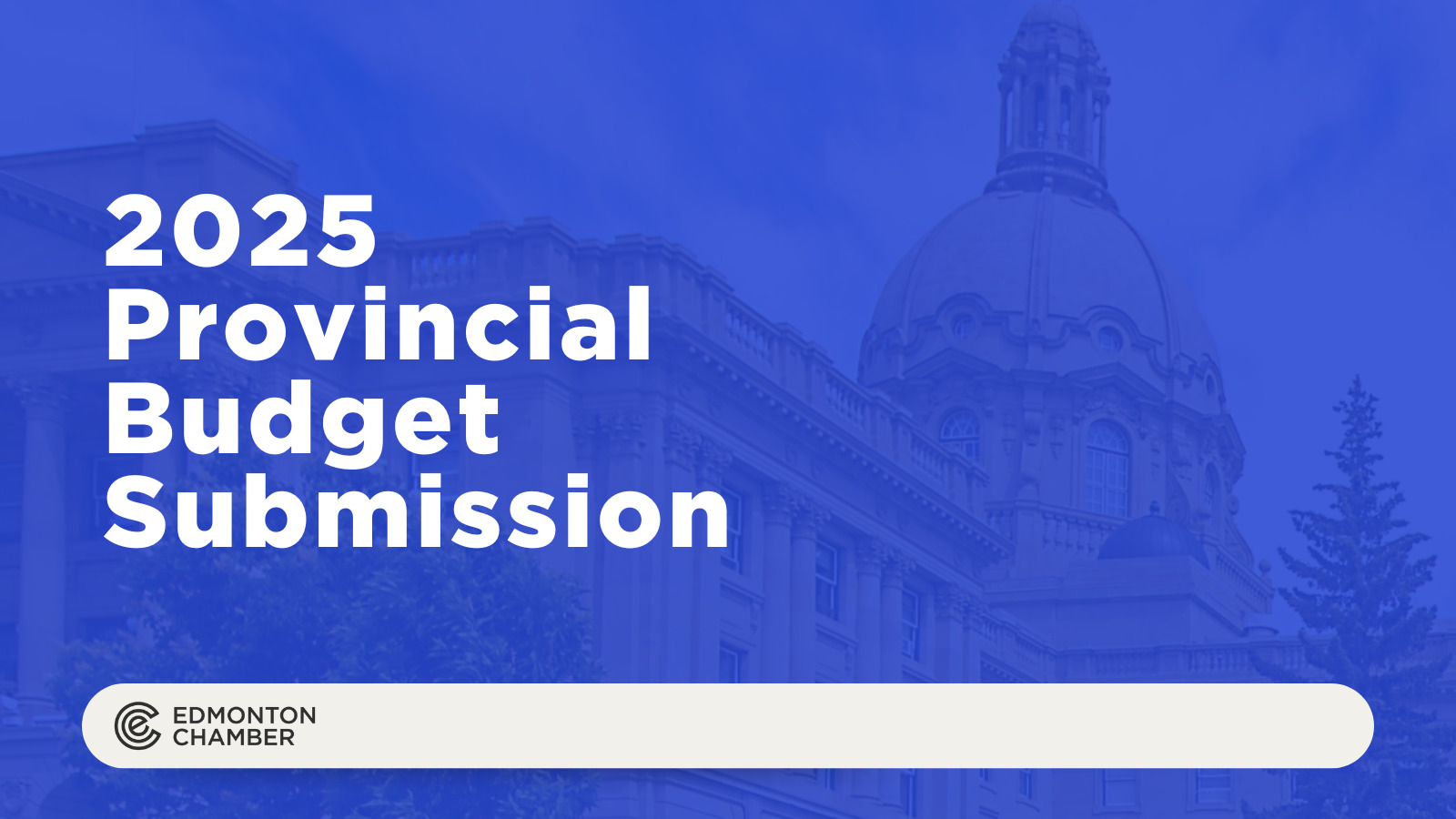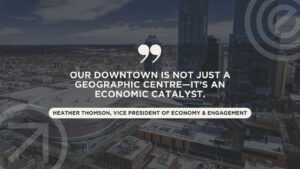January 21, 2025
Edmonton Chamber of Commerce Provincial Budget Submission (2025)

RE: Edmonton Chamber of Commerce Provincial Budget Submission (2025)
The Honorable Nate Horner:
I am honoured to submit for your consideration the Edmonton Chamber of Commerce’s recommendations for Alberta’s upcoming provincial budget.
For over 135 years, the Edmonton Chamber of Commerce has championed growth, innovation, and profitability in Edmonton’s business community. Representing nearly 2,000 businesses of all sizes that collectively employ over 100,000 Albertans, we serve as the voice of local business across an array of sectors - from small retailers to regional construction companies, to national heavy industry and manufacturing organizations.
We acknowledge the complexities of navigating Alberta’s dynamic political and economic landscape.We commend your government’s dedication to fiscal responsibility and the efficient delivery of public services while addressing the evolving needs of Alberta’s growing population. We believe prioritizing investments that drive economic growth - such as supporting entrepreneurs and employers, promoting trade and investment, and fostering a competitive business and regulatory environment - are essential to ensure Alberta remains the best place to live, work, and own a business.
Our budget proposal identifies five priorities designed to establish competitive, innovative, and prosperous business conditions in Alberta. Informed by consultation with our members organizations and the broader network of business and community leaders, we urge the Government of Alberta to:
- Strengthen our attractive and competitive business environment;
- Foster stronger regulatory certainty and efficiency;
- Focus on labour development and productivity;
- Invest further in municipal infrastructure and revitalization; and
- Support Edmonton’s growth as a global hub
The Edmonton Chamber is confident that investing in these priorities will solidify Alberta’s position as an economic powerhouse in Canada while also elevating the profile of our businesses, communities, and province to new heights on the global stage.
The Edmonton Chamber of Commerce is eager to collaborate with your government to shape policies and secure investments that enable business to thrive and communities to flourish. Please do not hesitate to contact me directly should you have any questions or wish to discuss this budget submission in greater detail.
Sincerely,
Doug Griffiths
President and Chief Executive Officer
Edmonton Chamber of Commerce
Appendix
Economic Context
Home to 4.8 million people and 121,682 businesses across 334 municipalities, our province created 70,000 new jobs and generated $344 billion CAD in gross domestic product (GDP) in 2023.Alberta’s population growth rate of 4.1% and economic growth rate of 2.4% outpaced all other provinces, reflecting the province’s strong momentum and economic resilience.
Alberta’s economy is also highly resilient and resourceful. Whereas Canada’s economic performance is slowing, Conference Board of Canada projections suggest that Alberta’s economy will grow on average 2.6% annually from 2025 to 2028. While challenges persist in the labour market, Alberta’s employment is projected to grow by 3.1%, with unemployment expected to decline to 6% by 2025. Consumers can expect relief from high interest rates and inflation thereby causing household spending to rebound by 2.4% over the next year. The strong economic performance is reflected in the province's most recent fiscal update.
On November 21, 2024, the Government of Alberta released its second-quarter fiscal update and economic statement for 2024, revealing stronger-than-anticipated financial performance. Revenue projections were revised to $77.9 billion, an increase of $4.4 billion compared to Budget 2024. Expenses saw a modest adjustment, rising by $100 million. As a result, the province expects a substantial surplus of $4.6 billion for 2024.
The province's commitment to reducing taxpayer-supporting debt and building the Alberta heritage savings fund is commendable. However, this financial windfall creates a window of opportunity for the province to make strategic investments that support Alberta businesses and stimulate further economic growth.
Businesses of all sizes—small, medium, and large—are key drivers of our province’s economic prosperity. Alberta businesses employ approximately 1.7 million people, issue the highest compensation nationally ($1,356 in average weekly earnings), and generate more than $24 billion in annual retail, wholesale, and manufacturing trade. Alberta businesses are also major contributors to the provincial tax base, having paid $307 million and $6.7 billion in small business and corporate income taxes in 2024. Maintaining an attractive and competitive business environment is critical for Albertans to continue enjoying the high living standards we’re known for.
Statistics Canada’s Canadian Survey on Business Conditions, Fourth Quarter 2024 captures business sentiments and perspectives across Canada. The most recent survey reveals that 71.6% of businesses reported an optimistic outlook for business over the next year. Furthermore, 42.6% of businesses expect to increase their average hourly wages, 19.3% anticipate raising prices on their goods and services, and 16.6% expect sales growth over the next quarter. This is a dramatic shift since the pandemic.
Despite this optimism, businesses remain deeply concerned about affordability and labour-related challenges. 65.7% of businesses identified cost-related challenges as the most prominent issue affecting their operations over the next quarter. Among these, rising inflation and increasing costs of inputs were anticipated by 44.1% and 37.9% of business, respectively. Labour-related challenges, such as experiencing difficulties in recruiting and retaining skilled employees or addressing labour shortages, were also expected by 37.3% of businesses.
This context highlights the critical role that small, medium, and large businesses play in driving growth and prosperity in our province. Businesses not only create high-paying jobs for Albertans, but they contribute significantly to the provincial GDP, foster vibrancy and dynamism in our communities, and help sustain the high standards of living that attract talent from around the world to our province.
By strengthening our attractive and competitive business environment, fostering regulatory certainty and efficiency, focusing on labour development and productivity, investing in municipal growth and revitalization, and supporting Edmonton in achieving its full potential, Alberta can sustain its momentum and build on its strengths, securing a prosperous future for businesses, workers, and communities across the province.
Budget Priorities
The Government of Alberta’s strong financial management creates an opportunity to invest in five key areas that will establish a more competitive, innovative and prosperous business condition in Alberta.
1. Strengthen our attractive and competitive business environment
A competitive business environment is essential for attracting talent, fostering entrepreneurship, securing investments, and driving innovation.Alberta’s business environment outperforms nationally, but much can be done to improve its global attractiveness and competitiveness.
- Eliminate the small business tax. Eliminating Alberta’s 2% small business tax would improve affordability and align our competitiveness with neighboring provinces, such as Saskatchewan (1%) and Manitoba (0%). This measure would save Edmonton small businesses $68 million annually, enabling reinvestment, hiring, and local spending. These savings allow our business community more opportunities to hire Albertans, reinvest in their business, or increase spending in the local economy.
- Reducing barriers to internal trade. Alberta’s regulatory framework for interprovincial trade is already strong. Improving mutual recognition of registration for worker’s compensation, health and safety rules, and labour mobility for licensed professionals will facilitate greater trade with businesses. The Business Council of Alberta estimates the province would yield $1.9 billion in additional tax revenues by reducing interprovincial trade barriers.
- Enhance the Alberta Petrochemical Incentive Program. Expanding the definition of “eligible capital”, extending project completion deadlines for eligible projects, and fast-tracking payment schedules for projects valued at over $150 million to two years, would improve the attractiveness of APIP.
2. Foster regulatory certainty and efficiency
Regulatory certainty and efficiency provide businesses and investors with a stable environment, reducing risks and fostering long-term planning and investment. Clear and streamlined regulations enable smoother operations, lower compliance costs, and encourage business growth and innovation.
- Balance financial and policy implications of regulatory changes. Alberta’s affordability and tax benefits are key advantages, but recent regulatory changes have raised costs for municipalities, causing financial instability and higher property taxes for businesses. The province must carefully balance financial and policy implications before introducing legislation that impacts affordability or creates uncertainty for businesses.
- Support business expansion into domestic and international markets. In 2023, 87% of Alberta’s $175 billion in exports went to the United States. A shift towards protectionist policies highlights the need to mitigate potential impacts and broaden Alberta's trade relationships. The province should invest in both domestic and international trade accelerator programs to boost local GDP and mitigate international trade risks.
- Create a longer-term fiscal plan. Build on the province’s strong fiscal management approach by adopting a fiscal anchor and long-term plan that is committed to reducing taxpayer-supported debt and investing future surpluses. The plan should include clear definitions, performance measures, and reporting, including clearly defined uses of funds (e.g. Alberta Heritage Savings Fund).
3. Focus on labour development and productivity
Focusing on labor development and productivity boosts business efficiency, innovation, and competitiveness, ensuring manageable growth. It also strengthens the economy by enhancing the workforce's skills, leading to higher wages, improved standards of living, and increased overall output.
- Reinstate the Canada-Alberta Jobs Grant. Alberta businesses relied heavily on the Canada-Alberta Job Grant that was suspended earlier this year due to federal funding reductions. 53% of businesses surveyed by the Edmonton Chamber indicated they will reduce planned training without this support. It is imperative that the province reinstate this program, or create a made-in-Alberta equivalent, to support businesses
- Incentivize technology adoption in small businesses. Artificial intelligence, automation, robotics, and other technologies are transforming businesses. To remain competitive, the province should incentivize technology adoption in small businesses by creating a new technology adoption grant or tax incentive. This would replace the Canada Digital Adoption Program that expires in March 2025
- Maintain a focus on productivity. Statistics Canada recently reported that Canada’s productivity is 4.5% lower than in 2019, emphasizing a persistent and widening productivity gap with peer countries. Alberta should build on the success of its Productivity Summit by developing a comprehensive strategy and targeted investments that enhance productivity in local businesses.
4. Invest in municipal infrastructure and revitalization
Investing in municipal infrastructure and revitalization enhances the quality of public services, attracts businesses, and improves the overall business environment. It fosters economic growth by creating jobs, increasing property values, and boosting productivity through improved transportation and utilities.
- Reinstate funding for the Grant-in-Place of Taxes (GIPOT) Program. The City of Edmonton, like other municipalities in the province, is facing increased cost pressures and challenges to financial sustainability. The province should reinstate full GIPOT funding retroactive to 2019 and commit to 100% ongoing support to help reduce ongoing tax levy increases, providing vital relief for businesses and residents facing an affordability crisis. Immediate action is needed to restore fairness for residential and non-residential taxpayers.
- Addressing public safety concerns. Edmonton businesses are increasingly concerned about public safety and social disorder. We commend the province for investing in 50 additional Edmonton Police Services officers, providing enhanced funding for local Police and Crisis Teams (PACT), and opening a local Navigation Centre. We urge the government to build on the successful Alberta Recovery Model by advancing other solutions that alleviate public safety concerns, such as opening the previously announced Recovery Centre in Edmonton, and investing further in local bridge and transitional housing.
- Develop a strategy for municipal infrastructure investment. Municipalities across the nation are struggling to address population growth alongside aging infrastructure. By 2007, decades of unstable government investment had led to a national infrastructure deficit of $123 billion (renewal) and $115 billion (growth). The province must prioritize working with all orders of government to develop a long-term strategy that addresses the growing infrastructure deficit and provides stable funding for municipal infrastructure growth and renewal.
5. Support Edmonton’s growth as a global hub
Supporting Edmonton to achieve its full potential is vital for businesses and the economy as it strengthens the city's role as a hub for innovation, commerce, and talent. A thriving Edmonton fosters economic growth, attracts investments, and creates new opportunities, benefiting both local businesses and the broader region.
- Connect downtown Edmonton to the airport. As part of the passenger rail master plan, a $25 million investment should be prioritized to create a direct rail connection between downtown Edmonton and the Edmonton International Airport. This will improve efficiency, reduce congestion, and support economic growth by enhancing connectivity for residents, businesses, and visitors
- Co-create a Downtown Attainable Housing Fund. The province should collaborate with all orders of government to create a $100 million Downtown Attainable Housing Fund. This fund would help address the growing need for affordable housing in Edmonton’s downtown core, supporting essential workers and families. This will ensure a vibrant, more attractive city while boosting economic growth in the heart of Alberta’s capital city.
- Invest in a strategic economic development plan for Edmonton. Calgary has secured significant investment and successfully positioned itself as a global city, but Edmonton has yet to reach its full potential. The province should contribute to a long-term economic development strategy that renews Edmonton’s vision, defines its comparative and competitive advantages, and repositions the city as a top 100 global city. Building on the City’s Economic Action Plan, and developed in collaboration with business, community, and municipal leaders, this strategy would drive growth and attract the investment needed to help Edmonton achieve its full potential.
Strategic Investments
In addition to the five budget priorities outlined above, the Edmonton Chamber of Commerce encourages the Government of Alberta to engage in discussions on longer-term strategic investment opportunities
Downtown Investment Plan
The Government of Alberta is invited to engage with the local business community on investing in the Downtown Investment Plan, co-authored by BILD Edmonton Metro, Downtown Revitalization Coalition, Edmonton Chamber of Commerce, Edmonton Downtown Business Association, and NAIOP Edmonton. The plan tackles declining tax revenues, high office vacancy rates, and the need for better public spaces. By partnering with businesses, the government can help create a vibrant, resilient downtown that attracts private investment and benefits residents. This collaboration is key to transforming Edmonton’s downtown into a thriving global city
World Trade Centre Edmonton
The Edmonton Chamber of Commerce invites the Government of Alberta to engage in meaningful discussions about the future of the World Trade Centre Edmonton (WTC Edmonton). As part of the global World Trade Centers Association, WTC Edmonton is well-positioned to drive economic growth and global connectivity. With plans for expansion by 2026, WTC Edmonton will enhance local businesses' access to international markets and foster greater diversity in global trade, in collaboration with Edmonton Global, Edmonton Unlimited, Export Alberta, and Invest Alberta
Alberta’s International Gateway to the North
Edmonton is uniquely positioned as a critical economic corridor, connecting Alberta to Western, Eastern, and especially Northern Canada through its strategic location, robust infrastructure, and advanced transportation networks. Unlocking its potential as a major inland port and a hub for trade, logistics, and commerce requires coordinated leadership and strategic planning. Led by the province, we call on the province and all levels of government to develop a strategy and prioritize investments in supply chain infrastructure, including expanded rail capacity, enhanced regional manufacturing, and business-friendly trade environments. Revitalizing initiatives like Port Alberta and Foreign Trade Zones have the potential to bolster Edmonton’s role in a national economic corridor strategy, driving growth, supporting trade, and increasing production.
Have your say.
The Edmonton Chamber wants to hear from you. What are the top issues and priorities for your business? Start the conversation by writing to policy@edmontonchamber.com





